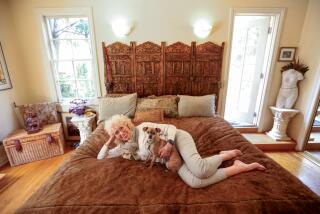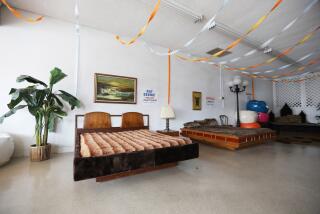INTERIORS : Bed-Making Rules Come Untucked
- Share via
In the military or on our own, many days of our lives start with making the bed.
The U.S. Army still has strict standards--beds made so tightly you can bounce a quarter on them--but most young people today aren’t nearly so fussy as Uncle Sam. In fact, most probably never heard of a hospital corner, the precise 45-degree angle created by tucking a flat sheet under the mattress corner.
Thank heaven, then, for the comforter. Big and fluffy, pull it up over the sheets, plump up the pillows and you have a socially acceptable alternative to the made bed. A good thing, too, considering a recent survey by Roper Starch Worldwide.
According to the 500 women surveyed, making beds is something younger women don’t do all that much. The survey in the April issue of Good Housekeeping magazine found that only 45% of women under age 45 make their beds every day. That compares with 71% of older women who make the bed daily. Don’t count on men to pick up the slack and pull up the bedcovers: 60% of the women say their mates never make the bed.
And 85% of respondents said they felt no guilt or only a mild unease at leaving a rumpled bed.
Susan Seliger, deputy editor of Good Housekeeping, which commissioned the poll, says that lack of guilt was good news to her.
“I don’t feel that making beds is a good use of my time,” says the fortysomething editor. “My mother would die if she didn’t make her bed every day. Enough of her training lingers so that I would close the bedroom door or quickly fluff up the comforter and throw on a quilt. I am enormously grateful for down comforters and quilts.”
Sales of bedspreads have been on the decline since the mid-1970s as the looser-looking bed became the standard at all price levels.
“The bedding industry sells significantly more comforters than bedspreads,” says John Fraley, vice president of the Martex division of Westpoint Stevens Home Fashions in New York. “Comforters, because of their practicality, will continue to be the major product focus.”
Yesterday’s bed with thin, flat spread precisely pulled up over tightly tucked sheets and a couple of flat pillows may look neat, but it also looks uncomfortable. Compare that with a puffy down comforter casually tossed over a fitted bottom sheet and a sea of plump pillows in a variety of sizes and shapes.
“It looks inviting,” Rose Gerace, speaking for Westpoint Stevens, says. “In photography for new bedding lines, we even show beds with the sheets turned down at a 45-degree angle. The photography also shows how to mix and match different patterns of sheets.”
That’s right. Not only do beds have that unmade look, sheets do not even need to match.
“In many ensembles, the top sheet is different from the bottom sheet,” Gerace says. “For example, a large floral for the top sheet and a small floral pattern on the bottom.”
The unmatched look started to show up about five years ago in expensive designer lines, she says. Now, it is an industry standard.
But what of military standards?
“The U.S. Army still wants beds made so tightly you can bounce a quarter on them,” Mike Griffin says. Griffin is public affairs officer and former drill sergeant at the U.S. Army Training Center at Ft. Jackson, S.C.
The standard operating procedure for bed-making on the base is hospital corners at 45-degree angles for both sheets--white and flat--and two government-issue blankets, Army green, of course. Even here, though, things are not what they used to be.
“There has been some lapsing,” Griffin admits, “because the emphasis is not on whether a soldier can make up his bunk, but on what’s between his ears.
“All hell doesn’t break loose if the bunk is on the wrinkled side.”
More to Read
Inside the business of entertainment
The Wide Shot brings you news, analysis and insights on everything from streaming wars to production — and what it all means for the future.
You may occasionally receive promotional content from the Los Angeles Times.










